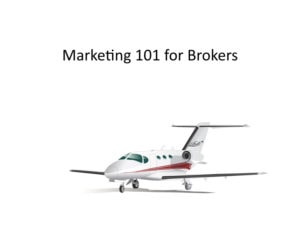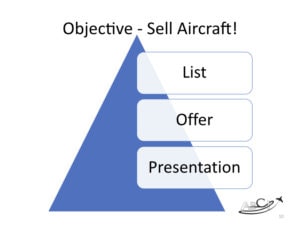Aviation brokers are in an interesting situation – they have to work with a number of different parties, build trust, create partnerships, and put together very complex transactions. At the same time, unlike real estate brokers, they are not required to be licensed or have any specific type of training.
In this video, we cover two basic marketing jobs required to be a successful aircraft broker:
1) How to acquire a listings
2) How to sell an aircraft.
In either case, it’s a marketing campaign. But these two jobs have a very different list of prospects, offer, and presentation.
We discuss various marketing tools and methods and how brokers can use them to do these two jobs successfully.
[embedyt] https://www.youtube.com/watch?v=8KwCdvhiCOM[/embedyt]
[smart_track_player url=”http://traffic.libsyn.com/aviationmarketing/Aviation_Marketing_for_Brokers_101.mp3″ background=”default” ]
Transcript – Aviation Marketing for Brokers 101
Paula Williams: Welcome to this week’s episode. Today, we’re doing a Marketing 101 for Brokers.
John Williams: Great.
Paula Williams: Yeah. A lot of the brokers that we work with don’t need a 101, so this is not for you if you already know what you’re doing, you’ve got it all figured out, you’ve got your campaigns running, you’ve got your list, your offer, your presentation down, and so on. This is basic marketing strategy.
So this is actually for people who are either just starting, or maybe they’re leaving an agency, going out on their own, or whatever the situation is. So this is the basics, right? Got to start somewhere.
John Williams: Okay.
Paula Williams: Yep. Not a darn thing wrong with starting from the beginning and doing it right. Right?
John Williams: That’s true.
This Episode Brought To You By Our Aviation Marketing Calendar
 Paula Williams: Okay. So this episode is brought to you by our beautiful marketing calendar. We just got these from the printer, so I’m kind of excited. They look really good, and they have all of the shows, all of the aviation shows, and the important dates, like the birthdays of our clients and other things in here.
Paula Williams: Okay. So this episode is brought to you by our beautiful marketing calendar. We just got these from the printer, so I’m kind of excited. They look really good, and they have all of the shows, all of the aviation shows, and the important dates, like the birthdays of our clients and other things in here.
So this is really good stuff and very specific to the aviation industry, and also, it has our goals for the month and our book club selections as well.
So you definitely want one of these if you are a broker, right?
John Williams: An aviation broker.
Paula Williams: An aviation broker. Not like the broker in Guardians of the Galaxy, right?
John Williams: Right.
Paula Williams: Buying and selling alien creatures and keeping them in cages and stuff. No, not that kind of broker.
John Williams: Good.
Here’s What We Know About Aircraft Brokers
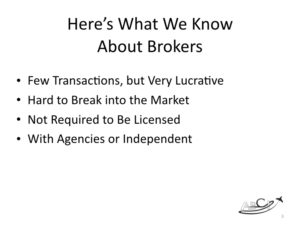 Paula Williams: Okay, cool. So here is what we know about brokers of the aviation variety. Right?
Paula Williams: Okay, cool. So here is what we know about brokers of the aviation variety. Right?
John Williams: Uh-huh (affirmative).
Paula Williams: We do a lot of marketing for brokers, and we enjoy working with them. They have few transactions every year, but those transactions are very lucrative, so this is not like retail. This is not like any other kind of sales that you’ve ever heard of. Right?
John Williams: True.
Paula Williams: Okay. It is very hard to break into this market. It’s a very high trust barrier, complex transactions, and so on. So this is not the easiest sales job you will every have.
John Williams: No, and selling and somebody saying yes is the easy part.
Paula Williams: Mm-hmm (affirmative).
John Williams: After that, it really gets difficult.
Paula Williams: Exactly. You are not required to have a license of any kind for aircraft brokering.
John Williams: That’s true.
Paula Williams: Yeah. For real estate, you do. For aircraft, you don’t, so go figure. And there are a couple ways of doing it, either with an agency, or as an independent broker.
So if you’re just starting out, you may want to consider either joining an agency that has some support and some of the things that you need to do and will provide a lot of these services for you, or getting together with a mentor of some kind who can help you with some of this, because this is not easy.
Just Starting Out? Consider a Mentorship or Joining an Agency
And we talked with a lot of folks that are maybe former airline pilots, maybe coming from another profession, or whatever, who are looking at breaking into becoming an aircraft broker, and sometimes we talk them out of it, and sometimes we talk them into either an agency or a mentorship of some kind with somebody that’s already established.
John Williams: Yeah. There’s at least 11 to 15 processes, each process having, oh, I don’t know, 80 to a 100 steps.
Paula Williams: Mm-hmm (affirmative).
John Williams: So you’d be-
Paula Williams: And we’re not-
John Williams: You can’t know it all.
Paula Williams: Exactly. And today, we’re not talking about the mechanics and the legal stuff and the documents and the processes of being a broker. We’re only talking about marketing for brokers, just marketing.
John Williams: Thankfully.
Paula Williams: Right, exactly. So this is not about how to buy and sell airplanes. This is how to market your services as a broker. So there are really two things that you need to do. One is to get listings, and the other is to sell airplanes, and those are both marketing tasks, and those are the only things we’re going to talk about today. Right?
John Williams: Works for me.
The Two Marketing Tasks of an Aircraft Broker
 Paula Williams: Okay. So like the Roman God, Janus, with two faces, there’s really two faces of this profession. One is two marketing tasks, really, of this profession. One is to get listings, and the other is to sell those aircraft once you get the listing.
Paula Williams: Okay. So like the Roman God, Janus, with two faces, there’s really two faces of this profession. One is two marketing tasks, really, of this profession. One is to get listings, and the other is to sell those aircraft once you get the listing.
Okay. So first of all, first marketing task is to get a listing, because until you get a listing, you have nothing to sell. Right?
John Williams: You have nothing.
Paula Williams: Okay. So every marketing campaign has three elements, and this might be the first of our podcasts that you’re listening to, because if you’re a broker, you may not have been with us from the beginning, or if you’re just getting into the profession, you may have never heard this before, so this is going to be super elementary. If this is your 400th podcast that you’ve heard, go get a coffee, come back in five minutes. We’ll be farther down the road.
Marketing for Brokers – Objective One – Get a Listing to Sell an Aircraft!
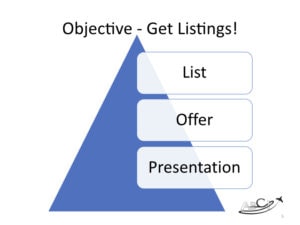 Okay. So a list, an offer, and a presentation, this is how marketing is done in every textbook on the planet. We don’t do random acts of marketing, because it’s a waste of time and money, and you just start doing ads without having outlined these three things, and I can just about guarantee that you’re going to spend more than you would have otherwise and get much worse results than you would have otherwise. Right?
Okay. So a list, an offer, and a presentation, this is how marketing is done in every textbook on the planet. We don’t do random acts of marketing, because it’s a waste of time and money, and you just start doing ads without having outlined these three things, and I can just about guarantee that you’re going to spend more than you would have otherwise and get much worse results than you would have otherwise. Right?
John Williams: Uh-huh (affirmative).
Paula Williams: You agree?
John Williams: Oh yeah.
Paula Williams: Okay. I remember you used to think this is a lot of work, and it is a lot of work, but it does work every time. So, if you want something that is certain, if you want to take the uncertainty out of this, you really want to make sure that you follow every step. Right?
John Williams: Yes you do.
Paula Williams: Okay. And if you’ve tried some of this before and it hasn’t worked, it’s because you’re missing a step.
John Williams: And she should know. She used to do this for banks and other companies for years and years before she got into aviation.
Paula Williams: Right, exactly. And almost always, if a marketing campaign fails, it’s because one of these three items is either missing or incomplete. Okay?
The List – Finding Prospects Likely to Choose You to Sell Their Aircraft
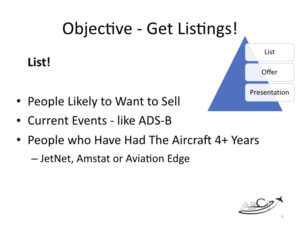 So, first thing, the list. The list is basically who are we going to talk to? Who are the kinds of people that are the most likely to be able to give us a listing? So, obviously, you’re looking for people who are likely to want to sell their aircraft, so obviously they’re aircraft owners, or managers, or people who are in the decision making capacity about that aircraft.
So, first thing, the list. The list is basically who are we going to talk to? Who are the kinds of people that are the most likely to be able to give us a listing? So, obviously, you’re looking for people who are likely to want to sell their aircraft, so obviously they’re aircraft owners, or managers, or people who are in the decision making capacity about that aircraft.
John Williams: True.
Paula Williams: So that narrows things down quite a bit. We don’t need to talk to everybody. We just need to talk to the people who are in a decision making capacity about an aircraft. So that just narrowed it down to less than 1% of the population.
John Williams: Oh, way down.
Paula Williams: Yeah. If you are buying advertising that is too broad, that’s the first mistake that brokers are likely to make, is they’re wasting money going after people who couldn’t possibly be customers. Right?
John Williams: True.
Current Events Inspiring Aircraft Sales
Paula Williams: Okay. All right. So some of the things you might want to look at are things like current events. Right now, we’ve got the ADS-B deadline coming up, where people who do not comply, they don’t have a compliance system in their aircraft, they are going to have to do something different. So they’re going to have to either stop flying their aircraft in the United States, or Canada, I think, is also covered by that in some way.
John Williams: Actually, Canada just-
Paula Williams: Has an extension, right?
John Williams: No, listen a minute.
Paula Williams: Okay.
John Williams: Canada, they were going to go with the same date we did.
Paula Williams: Yeah.
John Williams: They withdrew.
Paula Williams: Okay.
John Williams: So they didn’t say when it’s going to be due, so Canadian airplanes, after this 1st, will not be allowed to fly in the states.
Paula Williams: Right.
John Williams: So, if you don’t have ADS-B compliance, you can sell it to somebody in Canada?
Paula Williams: Yeah, exactly.
John Williams: Have a good time.
Paula Williams: Or sell it in Latin America, somewhere, Central South America.
John Williams: Almost all countries have signed up for this now.
Paula Williams: Really?
John Williams: Mm-hmm (affirmative).
Paula Williams: Okay. Sell it for parts. There’s a lot of people who are in the market to either get up to date on this or get rid of their airplane.
John Williams: Mm-hmm (affirmative).
Other Reasons People Sell Their Aircraft
Paula Williams: So there’s a lot of reasons that people may want to sell an airplane. Another reason might be, if the fuel price goes way up or way down, the aircraft that they have may become suddenly less attractive to them. Companies that are growing or shrinking, and if they’ve just laid off a lot of people, or they’ve just hired a whole lot of people, their needs have changed.
So something has changed. A current event has caused them to be potentially in the market to get rid of their current airplane, and if that’s the case, you want to be in the right place at the right time talking to the right people.
John Williams: And speaking of current events, I am not current on the Canadian thing. My information was about a week and a half old.
Paula Williams: Right, and then?
John Williams: So something could have changed.
Paula Williams: And by the time you listen to this podcast, something undoubtedly has changed, because we are talking about current events here. But there will be current events of some kind, whether that’s a regulation change or a price increase on fuel, air quality, noise at a particular airport. There’s always something that is causing the environment to change and somebody to want to unload their plane. Right?
John Williams: You bet.
Paula Williams: Okay. So another thing that you might want to look for are people who have had their aircraft for four plus years. That varies depending on the model of aircraft. Some people keep their airplanes for 10 plus years. Some people keep them for one plus years.
John Williams: Right. But statistically speaking, an aircraft that’s between three and five years old is probably going to be on the market soon.
Paula Williams: Right, for one reason or another. Either because they want to upgrade, downgrade, something has changed by that time. So how do you get this information? Well, the current events, you’re just going to have to get from your newspaper and use your imagination, keep your ears to the ground, read the industry publications, and so on, because those come from everywhere.
The people that have had their aircraft for four plus years, there are some services like JETNET, AMSTAT, Aviation Edge, AirPac I’m not absolutely certain that they have the ownership information and contact information for owners at AirPac. They may.
John Williams: Possibly.
Paula Williams: We’re not endorsing any one over the other. We personally use JETNET and love it, but you can use any number of things to get this kind of data and slice and dice it out to the criteria that you’re looking for and figure out how many of the make and model that you are looking to list are fitting that criteria and might be worth a phone call or a postcard or a targeted email ad, or whatever. Okay, so that’s the list.
Now that you have a list, you’ve got a list of people who are likely prospects that may want to sell a plane. Right?
John Williams: You bet.
Your Offer – Why Should they Choose YOU To Sell Their Aircraft?
 Paula Williams: Okay. Now you need an offer. What can you offer these people that is better than any of the other brokers out there? So maybe you have particular expertise in this particular aircraft type.
Paula Williams: Okay. Now you need an offer. What can you offer these people that is better than any of the other brokers out there? So maybe you have particular expertise in this particular aircraft type.
John Williams: Such as being type rated.
Paula Williams: Exactly. You may be in a location that is really ideal for that particular aircraft or for that person, so it’s really convenient for them too. You can go to the airport where the aircraft is and take the photographs and do everything, so location might be to your advantage.
Connections might be to your advantage if you happen to be part of an owner’s group for that aircraft and you know a lot of people who would be in the market, so you can use that as a selling point. Or credentials, and in this case, I’m talking about things like your A&P, if you have that, if you happen to be type rated in that aircraft, if you have a cam rating from MBAA. There’s lot of credentials that you might have that other brokers might not.
John Williams: Right.
Paula Williams: Since you’re not required to be licensed, we kind of make that up with other things to build people’s credibility in you as the right person to sell their aircraft.
John Williams: Exactly.
Your Presentation – How Do You Get Your Offer In Front of People With Aircraft to Sell?
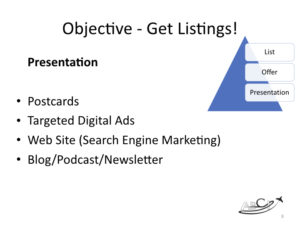 Paula Williams: Okay. So that’s the list, the offer. Third thing is presentation.
Paula Williams: Okay. So that’s the list, the offer. Third thing is presentation.
John Williams: Presentation.
Paula Williams: Right. Most people jump straight to presentation and start buying ads before they have really figured out the list and the offer. Okay. So this is where you do start buying ads or something. So postcards, these are kind of the traditional king in this market.
John Williams: Okay.
Postcards- the Traditional King
Paula Williams: Okay. Postcards are kind of the traditional king of this market. People get a postcard, and it’s really easy to get a list from JETNET and send a postcard to everybody who has a four plus year old aircraft of this type.
So there’s a lot of brokers who are doing this, because it’s easy, and because it’s simple, and because it works. So that doesn’t necessarily mean that you shouldn’t do it because everyone else is doing it, but that does mean that your postcard has to be good.
John Williams: Yes, well designed.
Paula Williams: Mm-hmm (affirmative).
John Williams: And the presentation… Excuse me. So if somebody gets it, even if they’re in process of throwing it away, they see what you’re doing and what you’re after, and they might say, “Oh, let me look at that.”
Paula Williams: Right. So your postcard needs to do two things. One is capture their attention.
John Williams: Mm-hmm (affirmative).
Paula Williams: And the best way to do that is to personalize and/or have beautiful photography of that particular aircraft make and model. You can personalize it even with their own tail number. There are some companies that will do personalized postcards that say, “Are you looking to sell this aircraft?” With the tail number on it, that will get their attention and they’ll hesitate over their garbage can.
And then, on the other side, you need to make sure that your offer is very clearly defined. “This is why I am the best person to help you sell this aircraft,” listing those credentials as we talked about. Okay, so postcards are great.
Targeted Digital Ads – The New Royalty
A new thing is targeted digital ads. This is really cool, because you can put in a list of email addresses, if you have them, from NETJET or anywhere else, JETNET, sorry, or anywhere else. Once you’ve compiled your list, you can put that in to Facebook, as an example, and target only that person. So when that person goes to Facebook, they will see your ad saying, “Are you looking to sell your aircraft?”
They have had some restrictions in the last few months, where you have to have a market of more than a thousand people. So, for some aircraft, like if you’re looking for certain makes and models of citations, there’s a thousand people there.
John Williams: Mm-hmm (affirmative).
A Web Site – Your Home on the Internet
Paula Williams: For others, you may not have a large enough audience for it to do that kind of targeting, but that is an option that wasn’t available to you earlier. Another thing, website, if you have the wherewithal to build or have built a website that attracts people who are looking for someone to sell that particular type of aircraft.
And by search engine marketing, I mean search engine optimization so that you come up first on Google when somebody types in, “I need to sell a G6,” or, “I need to sell a Caravan,” or whatever. If you come up first in those searches, either by paid searches or by natural, what we call organic searches, that will really help people find you if that’s what they need.
John Williams: I assume that you meant, by G6, the G600, and if that’s what you’re trying to sell, you’re selling a line position number.
Paula Williams: That’s true. Okay, fine. Okay. So blogs, postcards, newsletters, public speaking events, there’s a million ways to get your name out there and to establish your expertise and to talk about this make and model of aircraft and what you know about it, and maybe five things you should know before you sell your X type aircraft.
John Williams: Whatever it is, yeah.
Paula Williams: Brand X aircraft. Or public speaking at an owner’s group, other kinds of things, answering questions from people that you know, since you’re a specialist in that particular aircraft type, answering the question that people tend to ask about that, and other things like that.
So those are ways that you can present yourself as a broker, and you can write articles for the associations, or for your local chapter of the EAA, if it’s an EAA kind of aircraft. Those kinds of things are ways that you can do this.
So there’s lots of ways to do the presentation, and just about every marketing journal or information source out there will give you lots of great ideas, if you get the list and the offer right. If you don’t get the list and the offer right, then nothing is going to work as far as presentation. You can have the most fabulous, most expensive website, the most expensive postcards, and they’re not going to work, because you’re sending them to the wrong folks and you’re telling them the wrong things. Right?
John Williams: Sort of like buying a really spiffy looking airplane that doesn’t have an engine.
 Paula Williams: Right, exactly.
Paula Williams: Right, exactly.
Marketing for Brokers – Objective Two – Sell The Airplane!
Okay, so let’s talk about the other side of this transaction. You have successfully managed to run a campaign. People are contacting you, asking you to sell their airplane.
Success, right?
John Williams: At this point.
Paula Williams: Yes.
John Williams: The first half of it, yes.
Paula Williams: Absolutely. That’s a win. So you go out, you have champagne, you celebrate the fact that you got a listing. So you got your first listing for an aircraft. Now, you wake up the next morning.
John Williams: Say, “Oh shit.”
Paula Williams: Yeah, and hope you haven’t had too much champagne, because now you have some work to do.
Your Marketing Campaign for This Aircraft
Paula Williams: Okay. So, once again, we’re going to go back to the same triangle, the list, the offer, and the presentation, because you’re going to use the same process to sell the airplane.
John Williams: That’s right.
Paula Williams: Right? Okay. Every marketing task needs a campaign. Okay. So this time, your list is going to be-
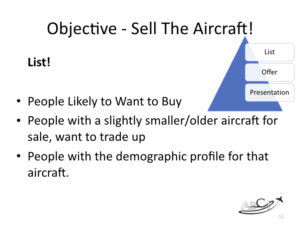 John Williams: Potential buyers.
John Williams: Potential buyers.
Your List of Potential Buyers
Paula Williams: … people who likely want to buy this particular make and model of aircraft. Right? So those might be people with a slightly smaller or older aircraft for sale, that will want to trade up. You can get those from Controller or Trade-A-Plane or whatever, showing this person is selling this aircraft. It’s likely that they’re in the market for something bigger, cooler, neater, more fabulous. Right?
John Williams: Faster, sure.
Paula Williams: Faster. Yeah, exactly. They’ve outgrown their old aircraft. Also, people who have the demographic profile for that particular aircraft, and I’m going to tell you what I mean in just a moment.
Geographical Location Suited to Aircraft Mission
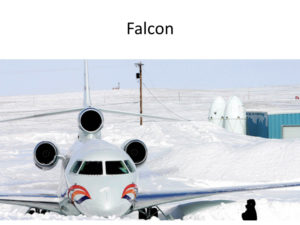 So if you were trying to sell a Falcon, for example, what would you do? Where would you go? Where is a really good place to sell a Falcon?
So if you were trying to sell a Falcon, for example, what would you do? Where would you go? Where is a really good place to sell a Falcon?
John Williams: A good place?
Paula Williams: Mm-hmm (affirmative).
John Williams: Location?
Paula Williams: Mm-hmm (affirmative). People that fly into Vail, right, because they have some restrictions. You can only take off during certain types of weather.
John Williams: Aspen, I think it is. Vail is okay.
Paula Williams: Yeah. I think it’s Eagle. Anyways, the closest airport to Vail in Colorado is a very high elevation airport with a really sharp turn coming out of the-
John Williams: Yeah. You can’t depart IFR unless you can do with one engine out.
Paula Williams: Mm-hmm (affirmative).
John Williams: And the tri-engine version of the Falcon makes it a nice one to do that with.
Paula Williams: Exactly. And so, you have an automatic advantage if you find somebody who has flown in or out of Vail, and you can get this information from JETNET, Flight Aware, a lot of different places.
People that fly in and out of Vail or Colorado airports, the high altitude, hot and high airports, on a frequent regular and basis using an airplane that only has two engines. Right?
John Williams: Yep. They also depart VFR.
Paula Williams: Exactly. So you could approach those kinds of people. Those would go on the list if I were trying to sell a Falcon.
John Williams: True.
Another Example – A Caravan
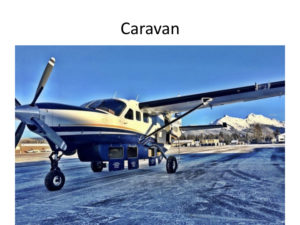 Paula Williams: Okay. So what list would you use if you were trying to sell a Caravan?
Paula Williams: Okay. So what list would you use if you were trying to sell a Caravan?
John Williams: Oh, FedEx.
Paula Williams: Okay. Yeah, some decision makers of FedEx.
John Williams: They use a lot of them.
Paula Williams: You would not sell this to a Silicon Valley entrepreneur.
John Williams: No.
Paula Williams: Right? You would not sell this to a movie star.
John Williams: No, probably a Doctors Without Borders, something like that.
Paula Williams: Exactly. So there’s a certain profile for people who need to carry a lot of stuff. They’re in certain industries, Alaskan bush pilots, people that deliver a lot of materials and things like that, companies that ship a lot of stuff, companies that have remote locations that they have to get to in a hurry, so oil and gas, industrial, agricultural, lots of things like that. So completely different audience, right?
John Williams: Yep.
Another Example – A G VI
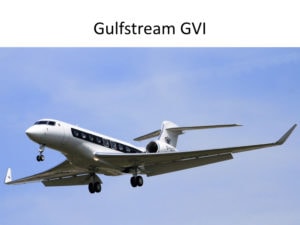 Paula Williams: Okay, so there’s your G VI.
Paula Williams: Okay, so there’s your G VI.
John Williams: Oh. Is it? No. Really?
Paula Williams: Wikipedia said it was.
John Williams: Okay. Well, whatever. That’s an entirely different audience.
Paula Williams: That is an entirely different audience. So these would be people who are companies of a certain size. Right?
John Williams: Mm-hmm (affirmative).
Paula Williams: So we’re talking a revenue threshold of, any idea? I don’t know. I’m just asking.
John Williams: Revenue thresholds for people who want to buy that?
Paula Williams: Mm-hmm (affirmative).
Do You Sell to Companies or People?
John Williams: No, it’s somewhere between $70 and a $100 million dollars, depending on age, what’s on it, and so on.
Paula Williams: Right. So, in this case, we’re talking people who-
John Williams: Or at least businesses with lots of money.
Paula Williams: Exactly, I was going to say. People say you sell these to companies. You don’t sell these to people, but in the final analysis, it is actually a person. A human being-
John Williams: Makes that decision.
Paula Williams: … is making that decision. So you’re looking for someone who is working for a company of that size, a founder, or a decision maker, who is in a position to buy or sell an aircraft like this.
John Williams: Yeah.
Paula Williams: Okay. And you’re looking for people that have multinational locations that they have to get to for clients or for branches of their company. So it’s really, the better you know the mission profile of your aircraft, the better you know the type of person who’s likely to buy this.
John Williams: Mm-hmm (affirmative).
Marketing to a Narrow Audience Reduces Your Costs
Paula Williams: So then you can narrow that down to, how do I find all of the companies of this size and above that have multiple locations, and then you just start checking them off. What we like to do is get what we call a top 10 list, especially for things like this, where it’s a super high ticket item, a super complex transaction, and everything else.
You’re not going to want to broadcast a lot of advertising. You want a top 10 list of people who are likely to buy this aircraft, and then you’re going to want to spend a lot of time researching those people and getting to know those people and cultivating that network. Right?
John Williams: Yep, you bet.
Paula Williams: So yeah, this is not spray and pray. This is sniper rifle, right?
John Williams: Yeah. It’s not going to happen overnight either.
Paula Williams: Exactly. So be willing and able to spend the time. These are not people that like to get in a hurry in any case, but especially the higher end the airplane, the more time it’s likely to take.
John Williams: Yep.
Paula Williams: Okay? Because more people are going to be involved in the transaction, and so on. Okay, so that’s your list.
Now let’s talk about your offer. What is that, in this case?
John Williams: Why?
Paula Williams: Yeah, why you should buy. Go ahead.
John Williams: You just talk faster than I do, so now you get to talk.
Paula Williams: Of course I do. Carry on.
John Williams: No, no, you.
Two Facts The Buyer Needs to Believe
Paula Williams: Okay. Why you should buy this aircraft type. So in the case of the Falcon, most people know, that have flown into that airport more than once, because they get snowed in a lot and they get stuck there a lot. So they may be aware of that. They may not be, but your job here is to help educate them on why this aircraft type is the best for their particular situation, assuming that you know their situation and you’ve done the research. So, of course, you do.
John Williams: Mm-hmm (affirmative).
Paula Williams: Okay, so that’s objective number one as far as your offer goes. Objective number two is to convince them of why they should buy this particular copy of this aircraft. Right?
John Williams: Mm-hmm (affirmative). Go on.
Paula Williams: And some of those things might be?
John Williams: Why they should buy this particular aircraft?
Paula Williams: Yeah.
John Williams: Depends on its mission and what your mission is.
Why is This Particular Aircraft The Ideal Choice?
Paula Williams: Exactly. So this particular aircraft is going to have a different history, it’s going to have different log books, it’s going to have different modifications that have been made to it from all the others that are on the market. There’s lots of things about it that may make it more ideal for a particular type of person.
John Williams: True.
Paula Williams: So how would you choose between two of the identical aircraft that are on the market? What are some of the differentiating factors that you would look for?
John Williams: Well, for me personally, because I ran a fleet of airplanes for the military, aircraft, I will go out there and I will stick my head under the landing gear and avionics compartment, and I can look in where the APU is. I can tell just by looking how the aircraft had been maintained, even if it has higher time than the other one. How the thing has been maintained is a hot button for me, because that means it’s likely to last longer.
Paula Williams: Right.
John Williams: It’d be a better value.
Paula Williams: So somebody that has maybe taken a very meticulous video of opening every door and looking at every crevice and having a really well lit fabulous tour of this airplane would make you more likely to get on a plane and go see it. Right?
John Williams: Oh, yeah.
Paula Williams: Okay. What else could they do to convince you that this particular copy of this particular aircraft model that you have already decided that you want is the one?
John Williams: I’d like to know where it has been.
Paula Williams: Okay.
John Williams: I mean, if it’s spent most of its life in a foreign country, I don’t want it.
Paula Williams: Mm-hmm (affirmative).
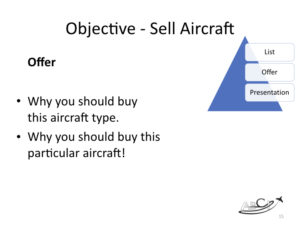 John Williams: I say that sincerely, but there may be one or two, but maintenance in this country is regulated a whole lot better than other countries, and besides that, the log books will be in English, and if it’s in a foreign country, it’s supposed to be in whatever their language is and translated into our language, but I’ve already discussed this with a broker.
John Williams: I say that sincerely, but there may be one or two, but maintenance in this country is regulated a whole lot better than other countries, and besides that, the log books will be in English, and if it’s in a foreign country, it’s supposed to be in whatever their language is and translated into our language, but I’ve already discussed this with a broker.
Paula Williams: Right, exactly. Okay. And there also are things like customizations of the interior maybe, maybe some engine modifications. You know those Black Hawk, where they add the extra blade, other things like that?
John Williams: That’s for a Black Hawk mod, yeah.
Paula Williams: Yeah.
John Williams: I thought you were talking about a jet, but anyway.
Paula Williams: Well, we did talk about Caravans, so, anything, right? We’re talking planes in general, so brokers of all sorts.
John Williams: Mm-hmm (affirmative). They have to know their airplane.
Paula Williams: Exactly. So what are the differences between this and the other aircraft on the market? And so, if you study the other aircraft on the market, you can see here are the things that are different, and here’s how I can show them off to my plane’s best advantage. Right?
John Williams: Right.
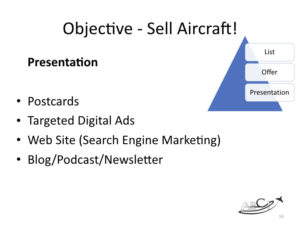 Paula Williams: Okay, cool. All right, so now we have a list and an offer of who might be a possible buyer for this aircraft and a reason that they might want to buy this particular airplane. How do I get that information in front of them? This is a key strategy for marketing for brokers.
Paula Williams: Okay, cool. All right, so now we have a list and an offer of who might be a possible buyer for this aircraft and a reason that they might want to buy this particular airplane. How do I get that information in front of them? This is a key strategy for marketing for brokers.
Your Presentation to Potential Buyers
John Williams: Many ways.
Paula Williams: Mm-hmm (affirmative).
John Williams: Same ways you did previously to get your list built.
Paula Williams: Yep. So if you start with a large list, you can do things like postcards and things like that to get it narrowed down a little bit. You can do targeted digital ads to people who land a lot in Colorado. You can do the website and search engine optimization.
You can make sure that yours is the most complete listing for that particular aircraft type that exists anywhere on the web. So if the others are 500 words, yours should be 800. Right? If the others do not have a video, yours should have a video.
John Williams: Right.
Paula Williams: If the others have three pictures, yours should have 12, so overkill is underrated.
John Williams: Exactly.
Paula Williams: Okay. If you can use a blog, a podcast, a newsletter that goes to a particular owner’s group of a particular type of aircraft, where you’re talking about these kinds of things, you can broadcast this more widely and use that. There will be a time at which it exits marketing and becomes sales. Right?
John Williams: True.
Paula Williams: So once that happens, somebody’s exhibited some interest, then it becomes being on the phone all the time with those people and answering their questions and providing them with documents and doing whatever is needed to take that sale the rest of the way. So the scope of today’s podcast is marketing, but then, at some point, that marketing becomes a sales test. Right?
John Williams: Which is the whole point of marketing.
Two More Words of Advice for Brokers
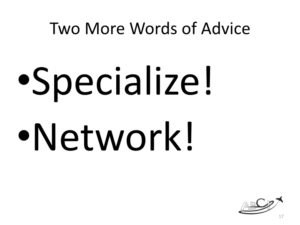 Paula Williams: Exactly. Okay. So we have two more words of advice for new brokers, or would-be brokers. Right?
Paula Williams: Exactly. Okay. So we have two more words of advice for new brokers, or would-be brokers. Right?
John Williams: Right.
Paula Williams: Okay. First one-
John Williams: Specialize.
Paula Williams: … specialize. Do not try to be “the everything broker.”
Credibility is a huge deal in this industry, so the more you know about a particular make and model of a particular type of aircraft, and the more you are known as the Caravan guy, or the whatever guy or girl, you want to make sure that that does two things for you. Number one, it allows you to concentrate your research, and number two, it allows you to become known for that, that specialty. And marketing for brokers who specialize is much easier, right?
John Williams: Yep.
Paula Williams: Okay. Second thing, network.
John Williams: Know people.
Paula Williams: Network like crazy, exactly, and that means online and offline, in the real world, in protein form, as they say, and also digitally. You want people to be able to find you very easily on the web these days, so all of that is very important.
John Williams: Yep.
 Paula Williams: Okay. So being a broker, we don’t want to talk you out of this profession if this is what you’re dead set wanting to do. We just wanted to make sure that you’re going in as armed and informed as you possibly can.
Paula Williams: Okay. So being a broker, we don’t want to talk you out of this profession if this is what you’re dead set wanting to do. We just wanted to make sure that you’re going in as armed and informed as you possibly can.
So there’s a couple more resources we’d like to offer that will help with marketing for brokers, and you can Google either of these, or we’ll put them in the notes for this episode. One is 17 Ways Aviation Salespeople Can Establish Authority, Credibility and Expertise, and those include things as simple as optimizing your LinkedIn profile and making sure you’ve got a good picture on there, to writing a book. So they’re all somewhere on that gradient of level of effort. Right?
John Williams: Right.
Paula Williams: Okay. But the more you do, the more of the 17 you have checked off, the easier your job as a broker will be, because the more credibility, authority, and expertise you will appear to have to other people.
John Williams: I mean, if you are able to, write a book on aircraft brokering, and on your card, you can say, “He wrote the book.”
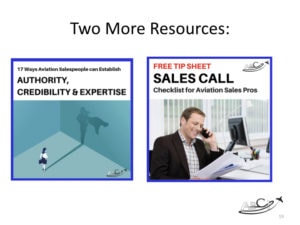 Paula Williams: Mm-hmm (affirmative). Yeah, especially for a particular type of aircraft or a particular, at least, genre of aircraft. Right? Okay.
Paula Williams: Mm-hmm (affirmative). Yeah, especially for a particular type of aircraft or a particular, at least, genre of aircraft. Right? Okay.
The other resource is a sales call checklist. You’re going to be doing a lot of sales calls, so that checklist is actually really helpful to make sure that every call is welcome and well received and effective.
John Williams: Right.
Paula Williams: Those are available for you.
Also, our aviation marketing calendar, we just had our calendar come out, so we’re really excited about it.
 This is the template where you do the one sheet for the entire year and hang that next to your wall calendar, and you’ve got the whole year planned out with some fabulous, fabulous marketing that is going to take you a long ways down the road of getting your list, to your offer, your presentation in front of the right people at the right time.
This is the template where you do the one sheet for the entire year and hang that next to your wall calendar, and you’ve got the whole year planned out with some fabulous, fabulous marketing that is going to take you a long ways down the road of getting your list, to your offer, your presentation in front of the right people at the right time.
John Williams: Exactly.
Paula Williams: Okay, cool. And then, of course, you can request our printed calendar and we’ll send you one if you are a broker or going to be broker. Right?
John Williams: Right.
Paula Williams: Okay. So thank you for joining us. Go sell more stuff.
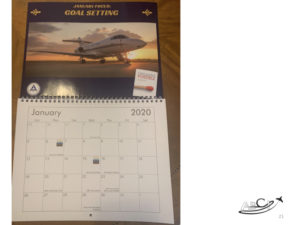 John Williams: Yeah, America sure needs the business, and thank you to Mr. Ziglar for saying that.
John Williams: Yeah, America sure needs the business, and thank you to Mr. Ziglar for saying that.
Paula Williams: Absolutely. Have a great afternoon and we’ll see you next time.
John Williams: See you later.
Podcast: Play in new window | Download
Subscribe: Spotify | Amazon Music | RSS

